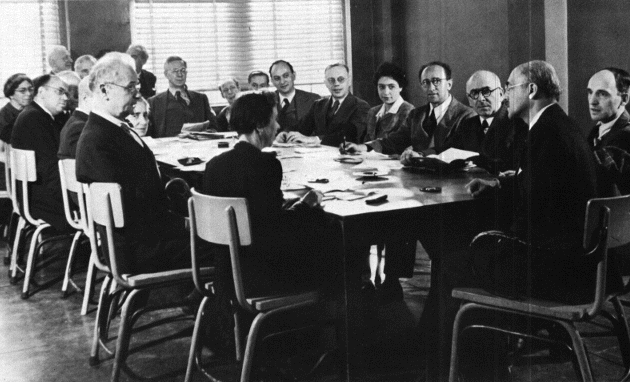| School | Troops | Resources |
Economics at the New School for Social Research
[Note: Part of the HET Website. This page is not related to or endorsed by the New School for Social Research or any other organization. See the official New School website]
The New School for Social Research was founded in 1918 in New York City by a group of prominent Columbia scholars - John Dewey, James Robinson, Charles A. Beard and Wesley C. Mitchell among others - dissatisfied with the state of academic freedom and the state of education in the United States and looking to recreate an American equivalent of the London School of Economics. Thorstein Veblen, who had in part inspired this rebellious group of scholars with his Higher Learning in America (1918), joined soon after and was accompanied by two more economists, the labor statistician Leo Wolman and the economist Alvin S. Johnson.
In its early years, the New School emphasized a "progressive" adult education as well as an independent social science research institute. It quickly became a regular address for prominent lecturers. John Maynard Keynes and Harold Laski were among the visiting economists in these years. Alvin Johnson, who took over as director in 1922, reorganized the New School, moved it to 12th Street in the thriving Greenwich Village bohemia of New York and expanded its role as a lecture forum.
During this time, it moved away from research and more into adult education and fine arts. But this was soon to change. Johnson's work on the Encyclopedia of the Social Sciences during the late 1920s with Edwin Seligman, a prominent Institutionalist economist and early patron of the New School, began to bring research back into prominence.
With Johnson's blessing, the New School hosted the Economic Forum, a journal founded in 1932, which served as a haven for heterodox academic and non-academic economists for some time. The Forum drew contributions from J.M. Keynes, W.T. Foster, Frank D. Graham, Benjamin Graham, John R. Commons, A.A. Berle, C.H. Douglas, Fredrick Soddy, Sir Josiah Stamp, Bertil Ohlin, Erik Lindahl, Paul Sweezy, etc. that would not likely pass the gatekeepers of orthodox American journals, until it was wrapped up in 1937.
Through the Encyclopedia, Johnson came in contact with many German scholars and quickly realized that the imminent rise of Adolf Hitler and the Nazi Party threatened to decimate the academic establishment of that country. Working closely with the Berlin economist Emil Lederer, Johnson helped found the "University in Exile" to accommodate the newly displaced and exiled German scholars. The University in Exile, which was later to become the Graduate Faculty for Political and Social Science of the New School, was a haven for many and, once again, the New School dedicated itself to scholarly research, quickly becoming one of the more prominent schools of social science in the United States. Emil Lederer, Hans Staudinger, Hans Speier, Frieda Wunderlich and Eduard Heimann were among the German economists who arrived at the Graduate Faculty.
The New School also virtually transplanted the entire Kiel Institute of economists - which included its head, Adolph Lowe as well as Jacob Marschak, Hans Neisser and Gerhard Colm. The Kiel Institute was recast under the New School as the "Institute of World Affairs" in 1942. Marschak, in turn, had gone on to hold his NBER-sponsored "Mathematical Economics" seminars which became the nucleus of the Cowles Commission. During this time, the L.S.E.-trained Abba Lerner and a young Italian economics student, Franco Modigliani had also joined the New School.
The refugee wave continued, particularly after the Austrian Anchluss and the onset of the War was netted by the Graduate Faculty. Among non-economists, the New School acquired the Gestalt psychologist Max Werthheimer, sociologist Max Ascoli, philosopher Leo Strauss, political scientist Max Lerner and the dramatist Erwin Piscator. The fall of France and the Benelux countries had led to the formation of the Ecole Libre des Haute Etudes, which housed prominent French thinkers such as Jacques Maritain and Claude Levi-Strauss and was, during the war, a haven for anti-Vichy activity.
The post-war years were made difficult for the New School by the return of scholars back to Europe or their move to other American universities. Although some economists, such as Lowe and Neisser stayed on, others, such as Marschak and Lerner, moved on to other schools. The McCarthyist hysteria of the 1950s strained the New School's resources even further. An injection of life was brought back with the arrival of the philosophers Hans Jonas and Hannah Arendt. In economics, Sidney Weintraub and Paul H. Douglas found a temporary haven, while Robert L. Heilbroner was elevated from Lowe's student to Lowe's colleague.
In the 1970s, further appointments were made: Edward J. Nell, Anwar Shaikh and David M. Gordon arrived at the New School, bringing with them their respective research programs in Post Keynesian, Marxian and radical political economy. The Cambridge connection was reinforced by the arrival of John Eatwell as part- time professor in 1982. In the 1990s, Lance Taylor and Duncan Foley joined the New School economics department and the Center for Economic Policy Analysis (CEPA) was founded to further the links between the New School's unique and refreshing perspective and the economic world.
| The First American Generation
The European Generation of Exiles
Later Figures
|
| HET |
|
Resources on the New School for Social Research
|
All rights reserved, Gonçalo L. Fonseca

